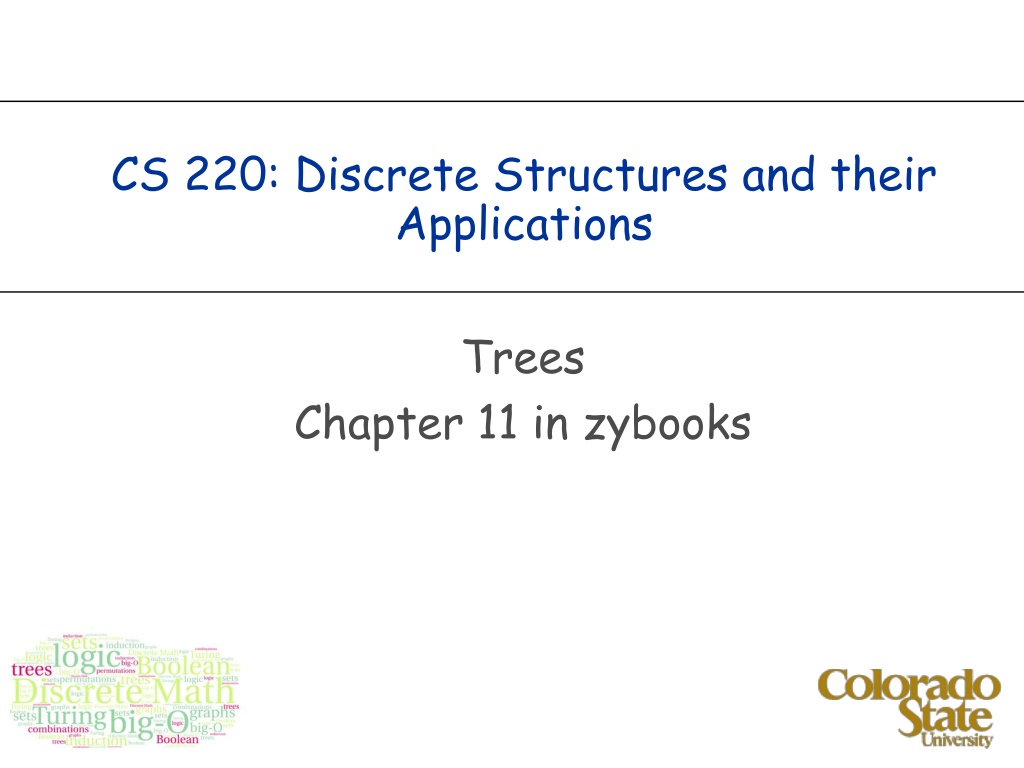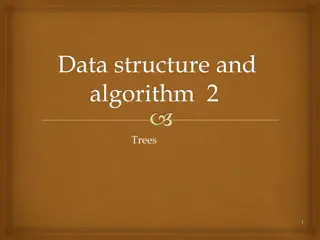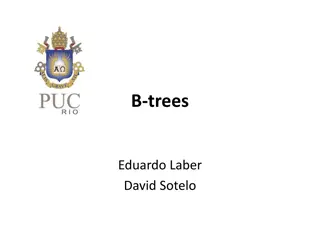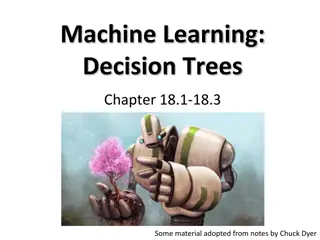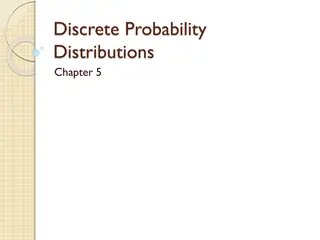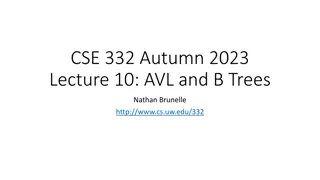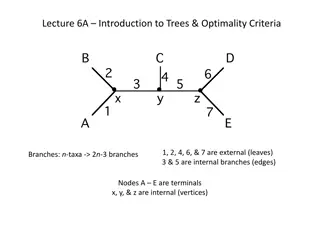Understanding Trees in Discrete Structures
Discrete Structures and Their Applications Trees Chapter discusses the properties and theorems related to trees in graph theory. Trees are defined as connected, undirected graphs with no cycles. The content covers the characteristics of leaves, internal vertices, and the relationship between the number of vertices and edges in trees. It also delves into rooted trees and their applications in modeling hierarchical structures, such as file systems. Additionally, game trees are explored as a representation of games with states and moves.
Uploaded on Oct 07, 2024 | 2 Views
Download Presentation

Please find below an Image/Link to download the presentation.
The content on the website is provided AS IS for your information and personal use only. It may not be sold, licensed, or shared on other websites without obtaining consent from the author. Download presentation by click this link. If you encounter any issues during the download, it is possible that the publisher has removed the file from their server.
E N D
Presentation Transcript
CS 220: Discrete Structures and their Applications Trees Chapter 11 in zybooks
trees A tree is an undirected graph that is connected and has no cycles.
properties of trees A leaf of an unrooted tree is a vertex of degree 1. If a tree has only one vertex, then that vertex is a leaf. A vertex is an internal vertex if the vertex has degree at least two. leaf internal vertex
properties of trees Theorem: Let T be a tree with n vertices and m edges, then m = n - 1. Proof. By induction on the number of vertices. Base case: is where n = 1. If T has one vertex, then it is has no edges, i.e. m = 0 = n - 1.
properties of trees Theorem: Let T be a tree with n vertices and m edges, then m = n 1. Inductive step: assume the theorem holds for trees with n-1 vertices and prove that it holds for trees with n vertices. Consider an arbitrary tree T with n vertices. Let v be one of the leaves. Remove v from T along with the edge e incident to v. The resulting graph (call it T') is also a tree and has n-1 vertices.
properties of trees Theorem: Let T be a tree with n vertices and m edges, then m = n 1. By the induction hypothesis, The number of edges in T' is (n - 1) - 1 = n - 2. T has exactly one more edge than T', because only edge e was removed from T to get T'. Therefore the number of edges in T is n - 2 + 1 = n - 1. Think of it as a rooted tree: every node except the root has 1 edge to its parent
rooted trees Rooted trees. Given a tree T, choose a root node r and orient each edge away (down) from r. root r parent of v v child of v a tree the same tree, rooted at 1
rooted trees Rooted trees model hierarchical structure. The file system as a rooted tree:
game trees games can be represented by trees: initial configuration player X player O The root is the initial configuration. The children of a state c are all the configurations that can be reached from c by a single move. A configuration is a leaf in the tree if the game is over.
rooted trees Rooted trees. Given a tree T, choose a root node r and orient each edge away from r. root level = 1 level = 2 The level of a node is its distance from the root The height of a tree is the highest level of any vertex.
rooted trees ancestor of v u child of u parent of v descendant of u v leaf Every vertex in a rooted tree has a unique parent, except for the root which does not have a parent. Every vertex along the path from v to the root (except for the vertex v itself) is an ancestor of v. A leaf is a vertex which has no children.
rooted trees v subtree siblings Two vertices are siblings if they have the same parent. A subtree rooted at vertex v is the tree consisting of v and all v's descendants.
traversal of a rooted tree A Pre order Process the node Visit its children B C A B D G H C E F I D E F Post order Visit the children Process the node G H I G H D B E I F C A
traversal of a rooted tree A Pre order Process the node Visit its children B C A B D G H C E F I D E F Post order Visit the children Process the node G H I G H D B E I F C A which node gets processed first/last in each of these traversals?
traversal of a rooted tree pre-order(v) process(v) for every child w of v: pre-order(w) A B C D E F post-order(v) For every child w of v: post-order(w) process(v) G H I
a trick for pre-order traversal To determine the order in which nodes are traversed in pre- order: Follow the contour starting at the root; visit a vertex when passing to its left.
a trick for post-order traversal To determine the order in which nodes are traversed in post- order: Follow the contour starting at the root; visit a vertex when passing to its right.
counting leaves with post-order traversal post-order-leaf-count(v) for every child w of v: post-order-leaf-count(w) if v is a leaf: leaf-count(v) = 1 else : leaf-count(v) = sum of leaf counts of children
computing properties of trees using post-order post-order-leaf-count(v) for every child w of v: post-order-leaf-count(w) if v is a leaf: leaf-count(v) = 1 else : leaf-count(v) = sum of leaf counts of children Other properties that can be computed similarly: the total number of vertices in the tree. the height
traversal of a rooted binary tree pre-order process the vertex go left go right post-order go left go right process the vertex in-order go left process the vertex go right level order / breadth first for d = 0 to height process vertices at level d
spanning trees A spanning tree of a connected graph G is a subgraph of G which contains all the vertices in G and is a tree. http://mathworld.wolfram.com/SpanningTree.html
computing spanning trees using graph traversal A spanning tree can be computed by a variation on DFS: dfs-spanning-tree() : T is an empty tree add v to T visit(v) visit(v): for every neighbor w of v : if w is not in T : add w and {v, w} to T visit(w) can also be computed using BFS.
weighted graphs A weighted graph is a graph G = (V ,E), along with a function w: E R. The function w assigns a real number to every edge.
minimum spanning trees Motivating example: each house in the neighborhood needs to be connected to cable Graph where each house is a vertex. Need the graph to be connected, and minimize the cost of laying the cables. Model the problem with weighted graphs Minimum spanning tree Spanning tree minimizing the sum of edge weights 4 A B 3 Incrementally build spanning tree by adding the least-cost edge to the tree 2 C
Prim's algorithm 8 7 a a b b c c 9 4 2 11 7 h h i i d d 4 6 7 8 10 g g f f e e unique? 1 2 {(d,c),(c,b), (b,i), (b,e), (e,f), (f,g), (g,h), (h,a) }
Prim's algorithm prims(G): Input: An undirected, connected, weighted graph G Output: T, a minimum spanning tree for G. T = pick any vertex in G and add it to T. for j = 1 to n-1 : let C be the set of edges with one endpoint in T and one endpoint outside T let e be a minimum weight edge in C add e to T. add the endpoint of e not already in T to T
27 The cut property Simplifying assumption. All edge costs are distinct. Cut property. Let S be a subset of nodes, S neither empty nor equal V, and let e be the minimum cost edge with exactly one endpoint in S. Then the MST contains e. The cut property establishes the correctness of Prim s algorithm. S e e is in the MST
28 The cut property Cut property. Let S be a subset of nodes, and let e be the min cost edge with exactly one endpoint in S. Then the MST T contains e. Proof. (exchange argument) If e =(v,w) is the only edge connecting S and V-S it must be in T, else e is on a cycle in the graph (not the MST). Now suppose e does not belong to T. Let e = (v',w') be the first edge between S and V-S on the path from v'. T' = T {e} - {e } is also a spanning tree. Since ce < ce , cost(T') < cost(T). This is a contradiction. S e v w v e w
